
The tree of life is the center of Lehi’s dream. «And it came to pass that I did go forth and partake of the fruit thereof; and I beheld that it was most sweet, above all that I ever before tasted.» (11)
The Tree of Life
In verse 12, Lehi acknowledges that he knew his fruit was preferable to all others, suggesting that there were more fruits and trees.

When Nephi in his vision sees the tree, he says to the Spirit; «I behold thou hast shown unto me the tree which is precious above all.» (1 Nephi 11:9) There is nothing in both experiences that suggests the existence of a single tree in the spacious field. Nephi points out that it is more precious than all of them, then there were others.
This scene reminds me of the one that took place in a garden. A place like a small field, more cared for and with an owner. There, Adam and Eve received this command: «Of every tree of the garden thou mayest freely eat, But of the tree of the knowledge of good and evil, thou shalt not eat of it, nevertheless, thou mayest choose for thyself, for it is given unto thee…» (Moses 3:16-17)
What trees could those be? I’m not sure, but I ask the question in another way: What are those trees called? I’m not sure either, but I know the name of one. «And moreover, I say unto you, that there shall be no other name given nor any other way nor means whereby salvation can come unto the children of men, only in and through the name of Christ, the Lord Omnipotent.» (Mosiah 3:17). We could add not one more tree.
No other name or path
Today this «yes yes, no no» class language is not popular. Political correctness gives all ideas the same value. However, not all have given the same result to the people and nations that have lived them.
It is like the joyful hiker who eats of every fruit he finds, considering that all are fit for man, for do they not all leave the earth? That simplicity will kill him.
Therefore the saints, as a people, adopt with preference the culture of light and truth from whatever position they are in.

That there is no other name, no other way, no other means, by which salvation will come to the children of men, but in the name of Christ, is a statement to the exclusion of all other names, ways, and means. Exclude is a word that is not well seen today. But is not every choice based on the exclusion of others?
The tongue is powerful in shaping thought. By acquiring, by emulation, the language of the scriptures, we protect ourselves against the banal.
When Lehi chose one of those trees, excluding others, he did not go around making diplomatic statements to apologize to those of other opinions who were under other trees. Nor did he wield an axe to cut them down. He did not praise the fine architecture of the building across the street. Nor did he take a dip in the river so as not to offend those who preferred to swim. Nor did he congratulate himself on the refreshing mist of darkness.
To place ourselves in the perspective of the gospel requires declaring that the king is naked. Today Lehi would be an exclusive person.
Towards the tree of life
Nephi and his vision of the tree of life

Looking at the artwork on Lehi’s dream, I know for sure that all those artists have read 1 Nephi, «Yea, and I beheld that the fruit thereof was white, to exceed all the whiteness that I had ever seen.» (11). In painting, as in real life, an object to be white, must be illuminated. And if its condition exceeds all whiteness, it must receive much light. It is easy to conclude from looking at the canvases that the main illumination originates from the tree, since it is the fruit that is illuminated.
The nature of the tree of life
Nephi in his vision receives a great deal of knowledge as to the nature of the tree. The Spirit of the Lord turns to him and asks him:
– Behold, what desirest thou? (1 Nephi 11:2)
– I desire to behold the things which my father saw. (3)
– Believest thou that thy father saw the tree of which he hath spoken? (4)
– Yea, thou knowest that I believe all the words of my father. (5)
They are talking about the tree, because it is the key to the vision. Then the Spirit of the Lord exclaims.
– Hosanna to the Lord, the most high God…And blessed art thou, Nephi, because thou believest in the Son of the most high God…» (6)
Nephi is more responsive than expected. He believes all his father’s words. Lehi spoke of a redeemer of the world…«he testified that the things which he saw and heard, and also the things which he read in the book, manifested plainly of the coming of a Messiah, and also the redemption of the world.» (1 Nephi 1:19)
The spirit breaks into praise, because Nephi’s response fulfills his expectations. The impression remains that the spirit of the Lord is surprised.
Just one yes
I believe that if Nephi had simply answered «Yes» in verse 5, the result would have been the same. Because the question the Lord asks in seeing. 4 is fully intended to lead him to the vision of the Messiah. There is a divine will in showing Himself to be like Sinai.
It is only after declaring his faith in Christ through his faith in the words of his father, that Nephi sees the tree.
When he sees the tree the Spirit of the Lord asks him:
The condescension
From that moment on he no longer sees the Spirit of the Lord and the direction of the vision passes to an angel. They will see the Messiah and his ministry, therefore the Lord withdraws.

The angel asks him a question as he shows Nephi a beautiful, pure virgin in Jerusalem.
– And he said unto me: Knowest thou the condescension of God? (16)
It’s an early question, Nephi doesn’t know. Neither do we. The angel, with that question, prepares him for the answer.
Someone who is condescending pleases others, tries to understand their feelings. In this sense, condescension is related to empathy. The word condescendere comes from the Latin condescendere (to lower oneself, to descend to someone’s level) but with a kindly spirit not out of obligation or necessity. Someone who is condescending does not use truth as a weapon, but understands others and patiently descends to their level and helps them from there.
God’s condescension is revealed in verse 18 «Behold, the virgin whom thou seest is the mother of the Son of God, after the manner of the flesh.»
Christ, the tree of life
Christ is represented in the tree of light, because the tree condescends with man in the same field and shares the same landscape. It offers a fruit of great value and high price within the reach of any hand. And that fruit comes from himself, from his own sap or what is the same, his blood. That fruit is within the reach of any height and the strength of any arm, that is why it is condescending, because it is adapted «to the capacity of the weak and the weakest of all saints» (D&C 89:3)
The light of that tree illuminates the scene, but it only lights up the heart of the one who eats its fruit. For that he must go after that tree and renounce others.
Participating in the tree of life

At home I want to hang in the hall a painting of Lehi’s dream faithful to the narrative. The tree lights up the scene. It is the vision of the one who receives the light of Christ and the testimony of the Holy Spirit. It is the vision of the blessed wayfarer, after his journey in the desert.
But what would that picture look like if it were painted from another part of that spacious field? How would other characters in that vision portray it? What would the illumination of the scene look like? Meditating on that has been one of the best experiences I’ve had with the scriptures.
«And when I ate of the fruit thereof, my soul was filled with exceedingly great joy» (1 Nephi 8:12)
The only full relationship with the gospel is to share in its fruit. Remaining on the periphery of the spacious field and staying in the knowledge of the scene is not to go ahead or to test. Many are satisfied with an intellectual knowledge of the gospel but do not eat. Others praise God but do not receive his covenants and ordinances.
Lehi does not taste the fruit as Adam did, but eats from it. Adam and Eve tasted the fruit as part of the protocol of the plan. Lehi eats the fruit to feed his soul and live. The gospel feeds and nourishes every day, not to test but to nourish. So Lehi, the father, does not stop eating while he searches for his family. To live only on one bite is like breathing only once.
The joy of Lehi
Lehi’s experience is complete. The love of God, which is poured out in his Son and the man who accepts him. There is no other way to know him. It is not an intellectual knowledge, but an intimate one, within us, that is why he eats.
In that large and spacious field where the scene takes place, Lehi feels an immense joy. Immense is a bigger concept than big and spacious. However, the fruit fits in one hand. Its greatness, therefore, is not in its dimension, but in the immense effect of tasting the fruit of God’s love.
Nor is the greatness of those who eat of it in their numbers, for they are few, but in having «were armed with righteousness and with the power of God in great glory.» (1 Nephi 14:14)
This love surpasses any extension of vision and landscape. Just as the gospel brings blessings, things that eye has not seen and ear has not heard (Isaiah 64:4)
All this, from the building, is not seen.

Nature of the fruit of the tree of life
Eating the fruit suggests I take your ordinances. One of them, the holy supper consists of eating and drinking. In the prayer every Sunday we hear, «…to the souls of all those who partake of it,…» (D&C 20:77). Participate in Latin participare (take part in something) and I would say be part of it, that is, the bread is already part of you. It is the most intimate communion with the gospel landscape.
It is not to live in a building like those opposite, but to be oneself a temple of the spirit.
If we go deeper into the ordinance, we can see that we participate one by one in reverence. We reach out our hand like Lehi and in the meantime, we meditate on the prayer we hear. It is centered on Christ, on remembering him and having his spirit with us. Centered on the tree we eat from.
They bowed and ate
In this ordinance, we do something strange in relation to the world. Like those Nephites who «they began to shout with a loud voice, because of their joy,» (3 Nephi 4:9), making their enemies believe that they had «had fallen with fear because of the terror of their armies.» (9) when «did not fear them; but they did fear their God and…» (10)
That same contrast is similar to the one between the people in the tree and those in the building. We testify that we remember Him in our posture of reverence, similar to those who «and fell down and partook of the fruit of the tree.» (30)

In all the ordinances of the gospel our body is involved, none is virtual. By eating the fruit, Lehi makes his body participate in the vision. He brings light and truth into it. He is no longer a spectator, but an agent.
Every Sunday, at the holy supper, we participate in the tree because that fruit is the love of God that is poured out on the children of men. Thus, without ceasing to take it, we continue our life without ceasing to call our own with our voice and with our gestures.
The father, the mother and the tree of life
«I began to be desirous that my family should partake of it also; for I knew that it was desirable above all other fruit.» (12)
Lehi being a lonely man so far (unlike Saríah who never stops being a mother) becomes a father and without stopping eating, he wants to share it with his family. It’s almost the natural step to try it, to share it.
The river of dirty water
While looking for his family Lehi finds a river, «I beheld a river of water; and it ran along, and it was near the tree of which I was partaking the fruit.» (13) He also uses this expression when describing the place where he pitched his tent in the desert «…he pitched his tent in a valley by the side of a river of water.» (1 Nephi 2:6) By this he makes it clear that he refers to a riverbed that carries flow and not to the dry riverbed.
We need to extend our understanding of the nature of that river, only then will we understand the role of Sarah, the mother.

The river Nephi saw
In Nephi’s vision, the angel explains to him the nature of that river. «And it came to pass that I looked and beheld the people of my seed gathered together in multitudes against the seed of my brethren; and they were gathered together to battle.
And the angel spake unto me, saying: Behold the fountain of filthy water which thy father saw; yea, even the river of which he spake; and the depths thereof are the depths of hell.» (1 Nephi 12:15 – 16).
Always relate this verse to the wars between the Nephites and Lamanites. In the sense of the evil of war. But if we read carefully, we realize that the angel describes that the one who was gathered against Laman and Lemuel’s posterity was the Nephites. Which is contrary to the commandments of God… «Ye shall defend your families even unto bloodshed…» (Alma 43:47)
The rule violated
This was the commandment and it was applied with this rule, «and they were also taught never to give an offense, yea, and never to raise the sword except it were against an enemy, except it were to preserve their lives.» (Alma 48:14). Therefore, the angel is describing the Nephite people in using a strategy that is contrary to the commandments.
The question would be, When did the Nephite people as a nation rush into the waters of that river? We can answer that when they broke the last commandment that separated them from destruction. The commandment to fight only in defense of their lives.
Year 362 on the banks of the river
We see this moment in the year 362 AD. After ten years of peace, when the terms were agreed upon with the Lamanites for the cession of land, they again attacked in 361 and 362. On both occasions they were defeated and this caused the Nephite people to begin to feel superior to their enemies. Again, they despised the tender mercies.

In 362 A.D. they began to dip their feet in the banks of that river of unclean water, «now, because of this great thing which my people, the Nephites, had done, they began to boast in their own strength, and began to swear before the heavens that they would avenge themselves of the blood of their brethren who had been slain by their enemies.» (Mormon 3:9) They were already prepared for their fall as a nation, blinded by their victories, their boasting and iniquities.
They were talking too much, when they should be quiet and checking the direction of the wind.
Day of flight in Padul (a parenthesis)
On one occasion I went, together with my fellow pilots, to Padul, a town in Granada, to attend a hang-gliding workshop. My friend Pablo, experienced in this sport, made an observation, I almost remember it to the letter:
«Before take-off, pilots usually have to concentrate on preparations, check the equipment, see the conditions, etc. When you see someone talking too much and bragging about their flights, those are the ones who will have the accidents.»
I always remember it when I feel like I’m part of 362.
Precipitation at the source of dirty water
After a sacrilegious oath for «…they had sworn by all that had been forbidden them by our Lord and Savior Jesus Christ,» (Mormon 3:14), Mormon withdraws from the command of the army.
In the year 363 they left the land of Desolation with their armies and were rejected. Mormon sadly acknowledges…» And from this time forth did the Nephites gain no power over the Lamanites, but began to be swept off by them even as a dew before the sun.» (Mormon 4:18)
That’s the river of water Lehi saw, running by the tree. That same river where the people of Jerusalem rushed. The one for which one of its citizens, prayed with all his heart as he went on his way. That river, pride, made them forget that we need their tender mercies.
The filth of the river

In a later explanation given by Nephi to his brothers, he tells them that…» the water which my father saw was filthiness…» (1 Nephi 15:27) and taught them that «it was an awful gulf, which separated the wicked from the tree of life, and also from the saints of God.» (1 Nephi 15:28)
It is very interesting the teaching of the angel to Nephi, because the decision of the year 362, was the one that totally removed them from the light of the tree, its fruit and even recognize it in the spacious field. Let’s say that the light went out for them.
They had actually dug that horrific chasm themselves. In that abyss there was «the horrible scene of the blood and carnage which was among the people, both of the Nephites and of the Lamanites; and every heart was hardened, so that they delighted in the shedding of blood continually.» (Mormon 4:11)
Lehi is looking for his family
As he searches for his family, Lehi sees the river near the tree of life «whose fruit [he] was eating» (13) but he does not see danger in its course. This is alien to him.
«…and at the head thereof I beheld your mother Sariah, and Sam, and Nephi; and they stood as if they knew not whither they should go.» (14)
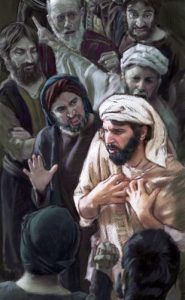
They were by the spring, because they lived in Jerusalem and the «unclean waters» that ran through its streets and its people were by its side. Jeremiah masterfully describes the situation in Jerusalem through his prophecies.
«For my people have committed two evils; they have forsaken me the fountain of living waters, and hewed them out cisterns, broken cisterns, that can hold no water.» (Jeremiah 2:13).
In these revealing words we see the Lord speaking of Jerusalem as His beloved: «As a fountain casteth out her waters, so she casteth out her wickedness: violence and spoil is heard in her; before me continually is grief and wounds.» (Jeremiah 6:7).
The corruption in the city was complete, with the various generations that were in the great and spacious building of her vision being the same as described by Jeremiah. «The children gather wood, and the fathers kindle the fire, and the women knead their dough, to make cakes to the queen of heaven, and to pour out drink offerings unto other gods, that they may provoke me to anger.» (Jeremiah 7:18)
Saríah’s work
This is the situation of corruption that besets Saríah as a mother. She does not walk like Lehi because she tends to the stable home, which collects and protects its own. In a siege you need a place of defense.
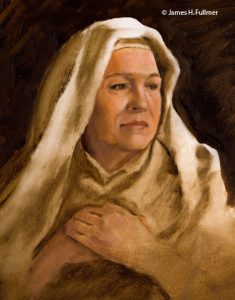
His family did not see the tree, although they were very close. They had not walked through the dark desert. They had not felt the need to pray for compassion with all their hearts on behalf of their people. The ministry of the man in white is directed to Lehi.
The way of Sarah is different from the way of Lehi, it gathers her children, waiting for guidance and knowledge. The protective mother who watches over her own, the land she supports. They are as if they do not know where to go but they have each other.
Saríah does know, unlike Lehi, of the danger of the river, because she manages to keep even Laman and Lemuel from walking too far from their father’s voice.
The quiet work
She does, however, know where they don’t have to go. She senses the evils that lurk more in the vicinity of her family than in her path. She quietly manages to keep these rebellious children from rushing into the troubled waters of Jerusalem, which have taken so many away.
Her mind is absorbed only in the details of that place that affect her family.
She waits for guidance and gathers her children ready to receive it. What an important role! But little esteemed today, by giving it a passive connotation. Yet how much strength there is in Saríah in sustaining the family unit without the presence of the travelling father. Just as in Ithaca Penelope supports the family without the presence of the wandering Ulysses.
The distances in Lehi’s vision
«and I also did say unto them with a loud voice that they should come unto me» (15)
The distance in this dream gives us an idea of the scene and its actors. Lehi tells us about his family who «…stood as if they knew not whither they should go..» (14). Guessing the situation or the attitude of these people brings us closer to 150 meters. At that distance we can interpret something of their situation. We can also raise our voice and send them signals with our arms.
Lehi communicates with her family, through the distance. The father, who is absent, directs his family to the tree. But without Saríah, it would be impossible because she is the one who provides him with a place to find them.
When Lehi sent her children to look for the plates, Saríah speaks to her in this way, «Behold thou hast led us forth from the land of our inheritance, and my sons are no more, and we perish in the wilderness.» (1 Nephi 5:2) Can anyone blame this woman’s words, when Lehi himself murmured about a broken bow and about running out of game meat that day?

Watchful always
In this case it is not a bow, it is their children. They are not next to her in that dark desert. She who always had them close. He always kept them together, ready to one day receive a father who was on his way and returned with a vision. She who, alarmed, saw the simplicity of Laman and Lemuel. Yes, when she heard them say that those who threatened her husband with death were “… a just people; [and her husband] had judged them, and brought them out because they listened to her words ”(1 Nephi 17:22). I imagine that these divergent tensions converged more on her than on anyone else.
But now no one was by his side.
Always vigilant of the danger that the river represented.
I don’t think Lehi could have put together two donkeys and a tent without Sariah.
The voice of the priesthood from the tree of life
The voice of the priesthood and its gestures through time and space. The present of the mother and the remoteness of the father, as a seeker in gloomy deserts or sentenced cities.
The voice of the father through distance. In Enos we read: «… the words which I had often heard my father speak concerning eternal life, and the joy of the saints, sunk deep into my heart..» (Enos 1:3)

The voice and the gestures of the father up to Alma «I remembered also to have heard my father prophesy unto the people concerning the coming of one Jesus Christ, a Son of God, « (Alma 36:17)
Lehi tells them aloud…to come to [him], yes, to his priesthood, along with his fatherly office. His family still does not see the tree with its fruit, they must be directed by his voice and his gesture. In the same way, they left Jerusalem without a certainty of what they were doing. Only trusting in his loud voice that called them into the wilderness, where they too saw no tree. Not even where they were to hunt in the moments of emergency.
They had no iron bar, but they had that familiar order, an order that is questioned today. And that family structure, which not even Laman and Lemuel dared to break at first, but at Lehi’s death, favoured orientation towards the tree.
The cohesion of Saríah, the mother
The family grouped by Saríah and guided by Lehi. A family with problems, which at times does not represent that ideal taught to us in church, but which fulfills the task the Lord outlined. Teaching with this, that it is his arm and not ours that carries the work towards its destination.
Moving this scene to our time, it would not be difficult to imagine a Saríah concerned with her profession. Under a strange tree, she dictates to those who approach her what it means to be a modern person. With a limited schedule for the heavy family tasks, where each spouse has their own horizon. Where sometimes they agree on some common purpose.
A Lehi who is absorbed in his path that coincides with the concerns of our time. A desire to get some children dangerously close to a river. A mother who is not there and a father who considers himself a mere provider of goods to live in that dark desert. There is no voice or gesture. Because that is already fixed by the code designed in the big building.
The strange tree

«…and partake of the fruit, which was desirable above all other fruit.» (15) One of those trees that Lehi and Nephi relate in their vision, when referring to the others, is detailed as they left their possessions and gold in Jerusalem.
By leaving them, Lehi indicates to his family that this tree they did not yet see was preferable to the one they left. To the gold and silver they left in Jerusalem and from which hung a visible and desirable fruit. Lehi thus works strangely in his environment. He leaves the family inheritance as something worthless and offers his family a land of promise that they could not see and did not know where it was.
The other tree
That fruit, which is desirable to make one happy, is found in a different way than others. Lehi does not completely abandon those tangible goods of his inheritance, but uses them appropriately as exchange value. Such as the attempt to exchange his wealth for the brass plates. In that way Lehi does not eat or feed his soul on that fruit, but uses it as exchange value.
Abraham did so «I, Abraham, saw that it was needful for me to obtain another place of residence;»… and wished to be, like Lehi, a seeker because… «And, finding there was greater happiness and peace and rest for me, I sought for the blessings of the fathers,» (Abraham 1:2)
Lehi traded his wealth for the bronze records «and searched them and found that they were desirable; yea, even of great worth unto us,» (1Ne5:21). We note here the difference between the exchange value of some fruits of that spacious field and the absolute value, in itself, of the bronze records, which are priceless. And like Abraham, Lehi desired these things «to administer the same;» (Abraham 1:2) to his family.
Lehi’s call to the tree of life
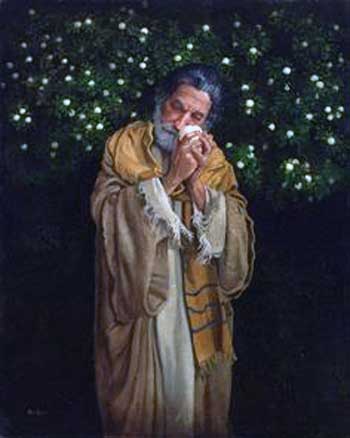
When describing the time when your family shares in the fruit we should note some important details.
«And it came to pass that they did come unto me and partake of the fruit also.» (16)
By saying they came to me, Lehi directs them to himself, not to the tree. Because they don’t see it yet. They only hear his words and gestures.
I remember the first assignment I received from Elder Jhon B. Dunford in the summer of 1976: To read from chapter 11 of 3Nephi to 28. I couldn’t see anything clearly then. I guess my perspective was similar to the group next to Saríah by the river when she heard her husband calling her from a distance. I think I agreed to read because for some reason I didn’t quite understand.
I decided to do what her voice and gestures asked me to do. But I didn’t do it because I saw some singular whiteness that shone not far from me. But because I was being called and I decided to go. They inspired confidence in me for some reason I did not know.
Tasting the fruit of the tree of life
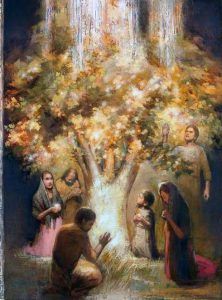
Each member of Lehi’s family eats the fruit in turn. When do they do it? Nephi in 1Ne2:16 «and behold he did visit me, and did soften my heart that I did believe all the words which had been spoken by my father». His brother Sam eats in turn the fruit as he hears Nephi testify «And I spake unto Sam…And it came to pass that he believed in my words.» (17)
And Sarah once saw that her children were unharmed, she believes «Now I know of a surety that the Lord hath commanded my husband to flee into the wilderness; yea, and I also know of a surety that the Lord hath protected my sons,» (1 Nephi 5:8).
These were the times of eating the fruit. That is why Lehi says I must rejoice in the Lord for Nephi and Sam’s sake.
Yet they fear for Laman and Lemuel because «… iI saw them, but they would not come unto me and partake of the fruit.» (1 Nephi 8:18).
Laman and Lemuel were also at the spring, but they did not want to go to their father, they did not accept the guidance of the father and the priesthood in order to reach the tree. However, they did not take the opposite path, and I sense that they were still in the distance but without breaking family ties.
Lehi, the savior
Lehi at this point represents the Savior by using the words came to me, came to me and did not want to come to me. The fruit is behind the ministering voice of the priesthood or the patriarchal voice. In the same way, Lehi follows the character in the white clothes and, after praying, finds and eats the fruit. Saríah and her family, follow the father in the desert and after praying and reflecting they also eat the fruit.
[su_box title=»Next article» style=»bubbles» box_color=»#2955ca»]

In the next article «Lehi’s dream map walking to the tree» we will see the dynamics of this vision. We will see who is moving, where and why. The elements of the vision frame these immense or small streams of people. We must meet and identify where we are.[/su_box]
Articles from the «Lehi’s Dream» project |

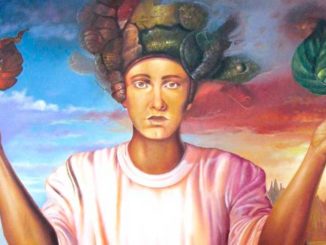

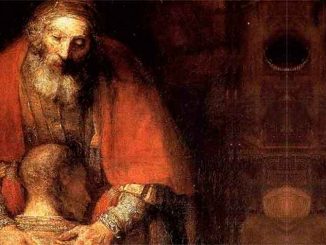
Be the first to comment